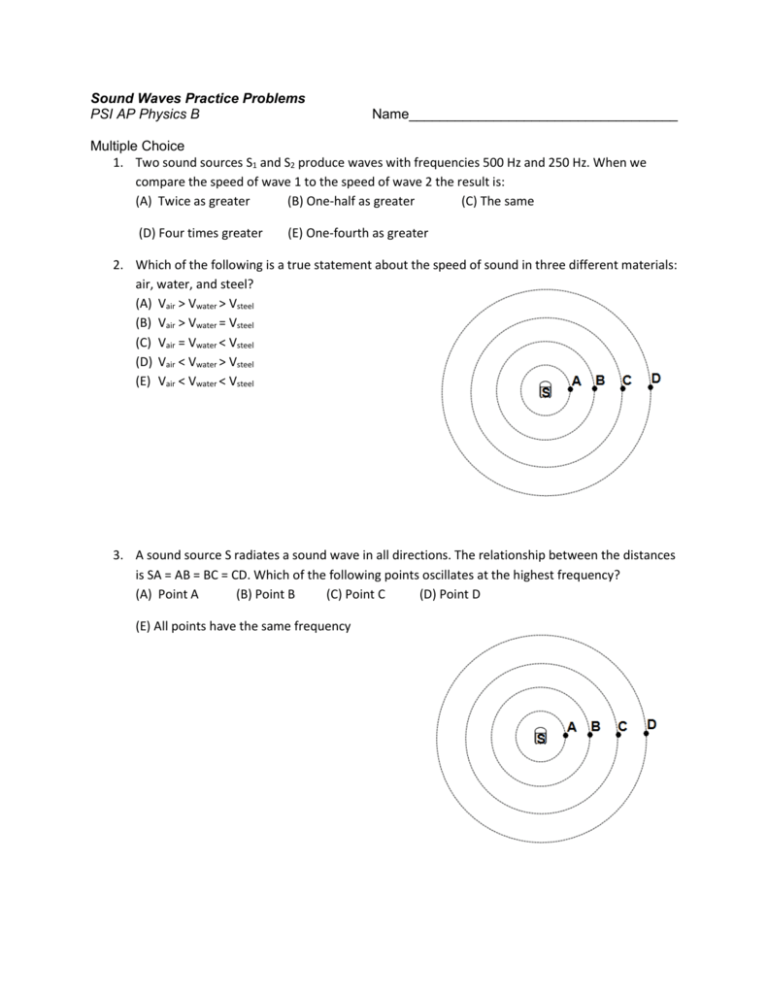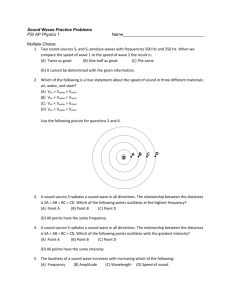Sound Waves Practice Problems PSI AP Physics B
advertisement

Sound Waves Practice Problems PSI AP Physics B Name___________________________________ Multiple Choice 1. Two sound sources S1 and S2 produce waves with frequencies 500 Hz and 250 Hz. When we compare the speed of wave 1 to the speed of wave 2 the result is: (A) Twice as greater (B) One-half as greater (C) The same (D) Four times greater (E) One-fourth as greater 2. Which of the following is a true statement about the speed of sound in three different materials: air, water, and steel? (A) Vair > Vwater > Vsteel (B) Vair > Vwater = Vsteel (C) Vair = Vwater < Vsteel (D) Vair < Vwater > Vsteel (E) Vair < Vwater < Vsteel 3. A sound source S radiates a sound wave in all directions. The relationship between the distances is SA = AB = BC = CD. Which of the following points oscillates at the highest frequency? (A) Point A (B) Point B (C) Point C (D) Point D (E) All points have the same frequency 4. A sound source S radiates a sound wave in all directions. The relationship between the distances is SA = AB = BC = CD. Which of the following points oscillates with the greatest intensity? (A) Point A (B) Point B (C) Point C (D) Point D (E) All points have the same intensity 5. The loudness of a sound wave increases with increasing which of the following: (A) Frequency (B) Amplitude (C) Period (D) Wavelength (E) Speed of sound 6. A sound wave travels from air into water. Which of the following doesn’t change? (A) Frequency (B) Amplitude (C) Speed of Particles (D) Wavelength (E) Speed of sound 7. A sound wave resonates in a tube with two open ends. What are the wavelengths of the three lowest resonating frequencies generated in the tube? (A) L, 2L, 3L (B) 2L, L, 2L/3 (C) L/2, L/3, L/5 (D) L/3, L/5, L/7 (E) 4L, 4L/3, 4L/5 8. The lowest frequency in an open tube is 300 Hz. What are the three following frequencies will resonate in the tube? (A) 600Hz, 900Hz, 1200Hz (B) 100Hz, 200Hz, 400Hz (C) 250Hz, 500Hz, 750Hz (D) 150Hz, 450Hz, 850Hz (E) 50Hz, 100Hz, 150Hz 9. The lowest frequency in an open tube is 200 Hz. Which of the following frequencies will resonate in the tube? (A) 50Hz (B) 100Hz (C) 150Hz (D) 250 Hz (E) 400Hz 10. A sound wave resonates in an open pipe with a length of 2 m. What is the wavelength of the wave? (A) 0.5 m (B) 1.0 m (C) 1.5 m (D) 2.0 m (E) 2.5 m 11. A sound wave resonates in an open pipe with a length of 4 m. What is the resonating frequency? (Vsound = 340 m/s) (A) 85 Hz (B) 170 Hz (C) 340 Hz (D) 510 Hz (E) 680 Hz 12. A sound wave resonates in an open pipe with a length of 3 m. What is the wavelength of the wave? (A) 1.5 m (B) 2.0 m (C) 2.5 m (D) 3.0 m (E) 6.0 m 13. A sound wave resonates in an open pipe with a length of 1.5 m. What is the resonating frequency? (Vsound = 340 m/s) (A) 85 Hz (B) 170 Hz (C) 340 Hz (D) 510 Hz (E) 680 Hz 14. A sound wave resonates in a tube with one open end. What are the wavelengths of the three lowest resonating frequencies generated in the tube? (A) L, 2L, 3L (B) L, 2L, 2L/3 (C) L/2, L/3, L/5 (D) L/3, L/5, L/7 (E) 4L, 4L/3, 4L/5 15. The lowest frequency in a closed tube is 300 Hz. What are the three following frequencies will resonate in the tube? (A) 600Hz, 900Hz, 1200Hz (B) 100Hz, 200Hz, 400Hz (C) 250Hz, 500Hz, 750Hz (D) 900Hz, 1500Hz, 2100Hz (E) 50Hz, 100Hz, 150Hz 16. The lowest frequency in a closed tube is 400 Hz. Which of the following frequencies will resonate in the tube? (A) 500Hz (B) 1000Hz (C) 1200Hz (D) 2500 Hz (E) 3000Hz 17. Two sound sources generate pure tones of 70 Hz and 80 Hz. What is the beat frequency? (A) 5Hz (B) 10Hz (C) 15Hz (D) 20Hz (E) 25Hz 18. A sound wave resonates in a closed pipe with a length of 1.5 m. What is the wavelength of the wave? (A) 1.5 m (B) 2.0 m (C) 2.5 m (D) 3.0 m (E) 6.0 m 19. A sound wave resonates in a closed pipe with a length of 3.5 m. What is the wavelength of the wave? (A) 1.5 m (B) 2.0 m (C) 2.5 m (D) 3.0 m (E) 6.0 m 20. A sound wave resonates in a closed pipe with a length of 2.5 m. What is the resonating frequency? (Vsound = 340 m/s) (A) 85 Hz (B) 170 Hz (C) 340 Hz (D) 510 Hz (E) 680 Hz 21. Two sound sources generate pure tones of 115 Hz and 130 Hz. What is the beat frequency? (A) 5Hz (B) 10Hz (C) 15Hz (D) 20Hz (E) 25Hz 22. Two sound sources produce waves with slightly different frequencies. What happens with the beat frequency if the frequency of the lowest tone increases? (A) Increases (B) Decreases (C) Stays the same (D) Increases and then decreases (E) Decreases and then increases 23. A sound source approaches a stationary observer at a constant speed of 34 m/s. If the frequency of the stationary source is 90 Hz, what is the frequency heard by the observer? (A) 90 Hz (B) 100 Hz (C) 180 Hz (D) 270 Hz (E) 360 Hz 24. An airplane moves away from a stationary observer at a constant speed of 340 m/s. The frequency of the sound wave of the stationary airplane is 780 Hz. What is the frequency heard by the observer? (Vsound = 340 m/s) (A) 1560 Hz (B) 780 Hz (C) 390 Hz (D) 195 Hz (E) 0 Hz 25. Two loudspeakers generate sound waves with frequencies of 680 Hz. What is the extra distance traveled by the second wave if a stationary observer detects maximum intensity of sound at point P? (A) 0.75 m (B) 1.20 m (C) 1.50 m (D) 1.60 m (E) 2.00 m 26. Two loudspeakers generate sound waves with frequencies of 680 Hz. What is the extra distance traveled by the second wave if a stationary observer detects maximum intensity of sound at point P? (A) 0.75 m (B) 1.20 m (C) 1.50 m (D) 1.60 m (E) 2.00 m 26. A sound source moves at a constant velocity Vobj and generates a sound wave. The speed of sound is Vsound. Which of the following is true about the direction and magnitude of the source velocity? Direction Magnitude (A) To the right Vobj > Vsound (B) To the right Vobj < Vsound (C) To the right Vobj = Vsound (D) To the left Vobj > Vsound (E) To the left Vobj < Vsound Free Response 1) Two loudspeakers separated by a distance d = 0.5 m are placed at a distance L = 2 m from y-axis. The loudspeakers generate waves with the same frequency f = 1360 Hz and amplitude A. The waves oscillate in phase. When a microphone moves in parallel to y-axis it can detect points with no sound or sound of maximum amplitude. (Vsound = 340 m/s) a. Determine the wavelength of the sound waves. b. Determine the angular displacement between the central maximum and first-order maximum. c. Determine the distance from the origin to the first point where the microphone detects no sound. d. If the loudspeakers oscillate in anti-phase, what is the new distribution in the interference pattern? 2) A group of students in a physics lab perform a series of experiments with a set of tubes and tuning fork. In the first trial they use a tube which length can be extended. The length of the tube when sound resonates for the first time is 0.5 m. (Vsound = 340 m/s) a) Determine the wavelength of the sound wave. b) Determine the frequency of the tuning fork. In the second trial the students use a tube with a constant length but they place in the tube a cork stopper with the same diameter as the inner size of the tube. The cork can freely move from the left side of the tube to the right. The frequency of the tuning fork stays the same as it was determine in the first trial. c) Determine the minimum length L0 of the left side of the tube when the air column resonates for the first time. d) What is the length L of the tube when the air column resonates for the second time? third time? 3. Two loudspeakers separated by a distance d = 0.75 m are placed at a distance L = 4 m from the y-axis. The loudspeakers generate waves with the same frequency f = 680 Hz and amplitude A. The waves oscillate in phase. When a microphone moves in parallel to the y-axis, it can detect points with no sound or sound of maximum amplitude. (Vsound = 340 m/s) a. Determine the wavelength of the sound waves. b. Determine the angular displacement between the central maximum and first-order maximum. c. Determine the distance from the origin to the first point where the microphone detects no sound. d. If the loudspeakers oscillate in anti-phase, what is the new distribution in the interference pattern? 4. A group of students in a physics lab perform a series of experiments with a set of tubes and tuning forks. In the first trial, they use a tube whose length can be extended. The length of the tube when sound resonates for the first time is 1.0 m. (vsound = 340 m/s) a. Determine the wavelength of the sound wave. b. Determine the frequency of the tuning fork. In the second trial, the students use a tube with a constant length, but they place in the tube a cork stopper with the same diameter as the inner size of the tube. The cork cn freely move from the left side of the tube to the right. The frequency of the tuning fork stays the same as it was determined in the first trial. c. Determine the minimum length LO of the left side of the tube when the air column resonates for the first time. d. What is the length L of the tube when the air column resonates for the second time? Third time? Answers MC: 1. 2. 3. 4. 5. 6. C E E A B A 7. 8. 9. 10. 11. 12. B A E D A B FR: 1. a) 0.25m b) 30° c) 0.5m d) In an opposite pattern. 2. a) 1m b) 340Hz c) 0.25m d) 1.25m , 0.75m 3. a) 0.5m b) 42O c) 1.5m d) In an opposite pattern 4. a) 2m b) 170 Hz c) 0.5 m d) 1.5m, 2.5m 13. 14. 15. 16. 17. 18. C E D C B B 19. 20. 21. 22. 23. 24. B B C E B C 25. A 26. E 27. C







